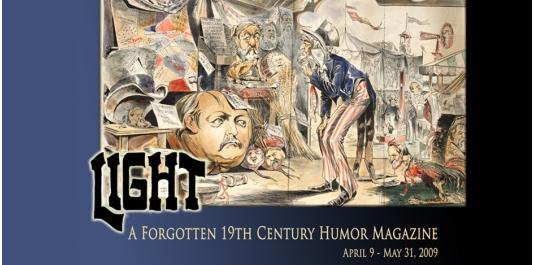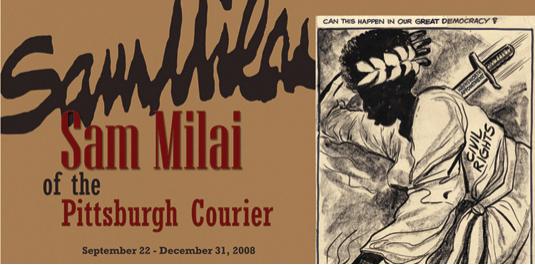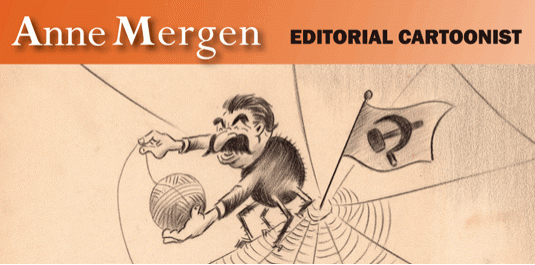Past Exhibits
 Light: A Forgotten 19th Century Humor Magazine April 9, 2009 - May 31, 2009
Light: A Forgotten 19th Century Humor Magazine April 9, 2009 - May 31, 2009 Light was by far the most important of lithographic comic weekly to be published outside of New York or San Francisco during the last quarter of the nineteenth century. It provided the first or early employment to a host of talented cartoonists, illustrators, and at least one writer who would later go on to successful careers. Those who contributed to Light included Will H. Bradley, W. W. Denslow, Frank Ladendorf, Ferand Lungren, Hy Mayer, Peter Newell, T. E. Powers, C. S. Rigby, and Horace Taylor. It also published the works of prominent New York cartoonists, such as Eugene Zimmerman and F. M. Howarth.
During its bumpy two-and-a-half year existence, the magazine’s one constant was change: it changed its name, its place of publication, its size and appearance, and its owners, editors, and chief cartoonists. It began in Columbus in March 1889 as The Owl. It changed its name to Light in June and suspended publication in September. It was revived in Chicago in February of 1890, went full-color in May, increased its page size in September, and published its final issue in June 1891.
 Ronald Searle: Satirist January 15, 2009 - March 31, 2009
Ronald Searle: Satirist January 15, 2009 - March 31, 2009 Ronald Searle: Satirist showcases examples of this great British cartoonist’s work at the height of his career as a graphic reporter during the 1950s and 1960s. Born March 3, 1920, to a working class family in Cambridge, Searle quit art school to join the Territorial Army as an Architectural Draughtsman in 1939. He was shipped to Singapore in October 1941, was captured by the Japanese a month after his arrival, He spent the remainder of World War II in a prisoner of war camp. Searle began cartooning for Punch in 1946 and was so successful there that he became a member of Mr. Punch’s Table, a very high honor, only a decade later. During this time, Searle also worked frequently for American magazines such as Holiday and Life. In 1960 he was the first non-American artist to receive the National Cartoonists Society’s Reuben Award, its highest honor.
 Sam Milai of the Pittsburgh Courier September 22, 2008 - December 31, 2008
Sam Milai of the Pittsburgh Courier September 22, 2008 - December 31, 2008 Sam Milai (March 23, 1908-April 30, 1970) was an artist and cartoonist for the Pittsburgh Courier, an influential African American newspaper, for thirty-three years. He was a centrist who disdained all forms of extremism. The cartoons in this exhibition were found by his granddaughter in a suitcase in her mother’s attic and donated to the Cartoon Research Library. The Sam Milai collection also includes correspondence, clippings and photographs related to Milai.
Sam Milai of the Pittsburgh Courier documents Milai’s mature work during the last seven years of his life. Reading these cartoons from the perspective of almost four decades later, we sense both the hopes and the frustrations that the African American community experienced during the 1960s.
 Jeff Smith: Before Bone May 1, 2008 - September 5, 2008
Jeff Smith: Before Bone May 1, 2008 - September 5, 2008 Jeff Smith brought a much more polished feature to the campus newspaper than most student cartoonists. From its inception, Thorn, the title of Smith’s OSU Lantern strip which was named after its female protagonist, exhibited an unusual level of sophistication. The strip demonstrated very capable manipulation of layout and design coupled with time-honored comic strip narrative techniques. It is interesting to note that by his early twenties, Smith clearly grasped the power of epic narrative, even though the storyline of Thorn, while sophisticated and entertaining, was not linear. The vantage point of a quarter century and the phenomenal international success of Bone make us see Jeff Smith’s college cartoons in a different perspective than we did when they first ran in The Lantern. At Ohio State University, the student newspaper describes itself as a “laboratory newspaper,” and it served that purpose very successfully for Smith. He used Thorn both to hone his artistic skills and to experiment with several types of storytelling. From a sketchbook page to finished comic strips, this exhibition celebrates the education of a young man.
 Anne Mergen: Editorial Cartoonist February 1, 2008 - April 11, 2008
Anne Mergen: Editorial Cartoonist February 1, 2008 - April 11, 2008 Anne Mergen’s editorial cartoons chronicle history from the Great Depression through the Cold War. During that time, she was the only woman in the nation working as an editorial cartoonist.
Mergen was born in Omaha, Nebraska, in 1906. She studied commercial art in Chicago before moving to Miami in the mid 1920s to work as a fashion advertising artist for a local department store. When the Miami Daily News, part of the Cox newspaper chain, hired her as its editorial cartoonist in 1933, she was the only woman editorial cartoonist in the United States, a status that continued until her retirement in 1956. She continued to have cartoons published as late as 1959.

